Think: Visual
—————-
By Beppe Colli
Oct. 8, 2013
During a discussion which took place on Steve Hoffman’s Forum, somebody
uploaded a link to a YouTube video: I immediately noticed that the protagonist
was Joni Mitchell, caught in the act in the course of her famous 1974 tour. I
would have liked to watch it pronto, but I was in a great hurry, and so I made
a mental note to watch it later that night.
Joni
Mitchell’s 1974 world tour, which saw her backed by Tom Scott’s band ("Let
me introduce this wonderful group, The L.A. Express" – so spoke la
Mitchell), was a very important moment for this Canadian musician, who at the
time was riding the crest of a high commercial wave thanks to her album Court
And Spark (an album that had Led Zeppelin’s Robert Plant fall so hopelessly in
love that he praised its many virtues in the pages of Rolling Stone) featuring
the hits Help Me and Free Man In Paris (and let’s not forget "sleeper
hits" such as People’s Parties, Car On The Hill, and Trouble Child). The
album that documented that tour being, of course, Miles Of Aisles.
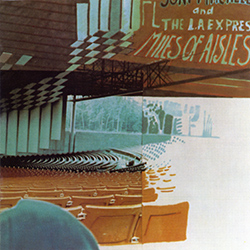
I was quite curious to watch the video. I clearly remember watching a concert video from that tour – "professionally filmed and recorded" – on a local TV station in the late ’70s, at a time when local TV stations used to broadcast rock concerts in order to fill air time. As witnessed by many bootlegs from this period – which I’ve never seen, nor heard – during that tour that line-up used to perform a lot of material off Court And Spark, this album being (understandably) underrepresented on Miles Of Aisles, which gave newcomers a crash course on Mitchell’s past releases on Reprise.
The video – just one song, really – proved to be the proverbial letdown, a pink-tinted thingee which didn’t really look as having been "professionally filmed and recorded". What a pity!
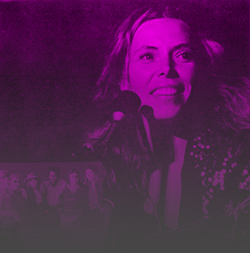
Having closed the window, I was offered the choice of "Joni Mitchell live at Wembley, 1974, with CSN&Y, Old Man". (By the way, it looks like the 1974 Crosby, Stills, Nash & Young world tour is about to become a hot topic all over again, with lotsa unreleased recordings about to appear on the legit market, though it seems that the Wembley concert won’t be included in the package: "It was awful", said Nash.) Old Man is the Neil Young classic we all know and love, Joni Mitchell briefly appearing in the guise of a backing vocalist. There’s a bass player (Tim Drummond?) who tries hard to make eye contact with Young, but, alas!, with not much success. It looks like Young just had something a lot stronger than a double espresso: his performance is impeccable, but the incessant movement of his legs, which greatly accelerates as the song moves to its close, has the viewer believe for a moment that Young is about to levitate. The shout from the crowd – 72.000 strong, or so I’m told – at the end of the song appears to "wake" Young, who looks very spaced out indeed.
I was then offered the option "Joni Mitchell Live at Wembley 1983 – BBC – 29′ – pt.1", which I decided to take. It’s an excerpt from the tour which featured the "rock" line-up – also a lot of the material – from her album Wild Things Run Fast
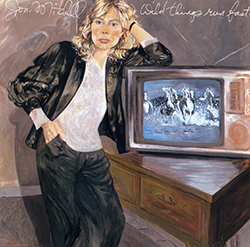
which saw Joni Mitchell go back to a more "immediate, user-friendly" direction – at least, when compared to the material birthed by her collaboration with jazz giant Charles Mingus, featured on her album titled Mingus.
The video – filmed and recorded with great clarity: I immediately decided to watch pt. 2 – mirrors with great accuracy what appeared on the Wild Things Run Fast album, Mike Landau a bit too hyper-active on guitar. As it was to be expected, some songs from the old repertory – for instance, the highly-celebrated Song For Sharon, which here is given a heavy dose of amphetamines – are not really suited to this line-up. But there’s a solo rendition of Woodstock which is really fantastic.
The concert features Joni Mitchell wearing her famous beret, an accessory that a couple of years later she wore again on the cover of the highly-lamented US monthly magazine Musician.
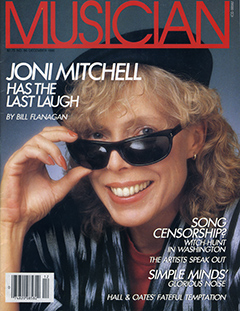
The line about "has the last laugh" won’t say much to those who ignore the fracas originated by the cover of the highly acclaimed, and commercially formidable, debut album (1979) by US singer-songwriter Rickie Lee Jones, who was photographed while wearing the accessory

that Mitchell herself had previously worn on the cover of Hejira (1976).
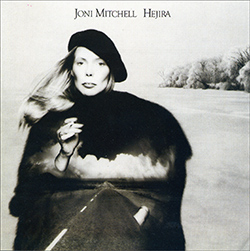
It was at this moment that I was made an offer I could not resist: Joni Mitchell live at the BBC, 1970. Dinner could wait. Here was Joni Mitchell with lotsa hair, lotsa teeth, and a fine acoustic guitar played with great skill and finesse.
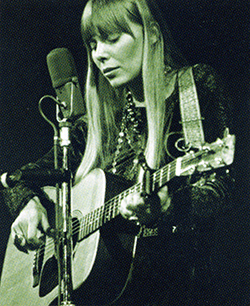
The recorded sound was incredibly clear and detailed, with no mike bleed, proving once again that, once upon a time, sound engineers really knew their trade: vocals, guitar, dulcimer, a shiny grand piano, everything sounded perfect. The repertory came off Joni Mitchell’s first three albums, with two unreleased songs (!) that in a short while would appear on the highly-celebrated Blue (1971) being performed live: My Old Man, whose lyrics at the time were not finished yet; and California – here we’re told about the circumstances which saw this song being composed. A fantastic storyteller, Joni Mitchell captures the full attention of those who attended this concert for TV, invitation-only, I think. I couldn’t believe my eyes, that was… Peter Green! sitting there, looking as he’d been given to rapture.
Totally by chance, I find myself having a look at the vinyl section of a shop that’s part of a large national chain. I happen to see a couple in their late teens approaching. He starts to examine the LP covers, while making brief comments. She doesn’t say much. "Hey, have a look at this!", he says, like he’s found something he thinks it’s really good. I slowly turn my head while at the same time pretending to look at the cover of Neil Young’s Live At Massey Hall, the album in question being Abbey Road by The Beatles. I’m a bit surprised, and I’d like to say something, but I bite my tongue.
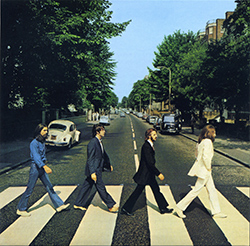
The boy has really done his homework, and so he proceeds to talk about the famous "Paul Is Dead" rumour, with lotsa details, including those naked McCartney feet, and the Volkswagen Beetle car parked on the left with 28 IF appearing on the car plate. She listens attentively. It’s at this moment that I really open my ears, waiting for their comments about the music. It’s with great surprise that I notice that this particular conversation is over. The album goes back to its place, the couple walk away. I bite my tongue, barely suppressing my desire to shout: "What about the music, then?".
Now I’m gonna formulate an assertion that I’ll immediately define as not really being up to my satisfaction, which could have many possible exceptions, and is definitely in need of fine-tuning, but I’m afraid that for now it’ll have to do. It sounds like this: For those who came of age in the ’60s the music was first "listened to", then "watched". (A factor that gradually becomes the opposite, in the time continuum.)
It ain’t a great revelation: It just means that the prevailing dimension of the way the music was consumed at that time – on the radio, on one’s vinyl records – was sound.
Which doesn’t entail negating the importance of famous TV music programs such as U.K.’s Ready, Steady, Go! and Top Of The Pops, or Germany’s The Beat Club.
Nor epiphanies on a national scale such as The Beatles appearing on The Ed Sullivan Show (or their movie A Hard Day’s Night), or The Rolling Stones, or The Doors refusing to change the lyrics to their song Light My Fire, so creating a pandemonium.
On a much smaller scale, Italy saw the US "noisy psychedelic" quartet called The Vanilla Fudge play live on national TV at the 1969 edition of the Venice song Festival (to anyone’s amazement, they won), performing their 7′ cover of Some Velvet Morning, off their album Near The Beginning.
The most important moment for one’s appreciation of music was listening. A moment that also had a very strong social connotation, given the fact that it was not uncommon for people to listen to music collectively. Let’s not forger those long hours spent talking about music.
In order to make the difference between now and then as clear as possible, I’ve chosen the group that in my opinion best embodies today’s "visual" connotation of music: The Doors, a group that today is immediately recognizable even by those who have never heard a single note of their music.
A popularity that in the 60s nobody would had thought to be possible, let alone more than forty years after the fact. Let’s keep in mind that at the time the "celebrity chart" saw the colossal Beatles perennially sitting at # 1, with The Rolling Stones and Bob Dylan alternating at # 2 and # 3.
At the time, things were a lot more difficult for US groups who wanted to "break" Europe, the Atlantic being wider and deeper than now. But if it would be an exaggeration to say that in Europe The Doors were as famous as, say, Spirit, arguing that their popularity was about the same as, say, The Jefferson Airplane, would not be off the mark, the Airplane being the group the Doors shared the bill with during their 1968 European tour, those gigs at London’s Roundhouse included.
It goes without saying that at the time The Doors were high on the charts, with hit singles such as Hello, I Love You, Touch Me, and Tell All The People. Which takes us back to the "music as sound", those singles and LP covers being what most listeners knew of the way the group looked.
But when listened to The Doors sound like a quartet, not like a singer backed by three players whose names nobody bothers to learn anymore.
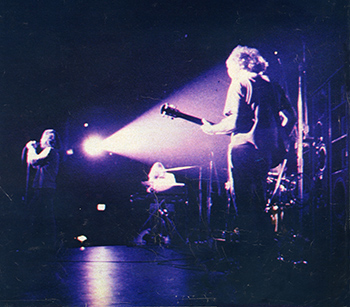
Given this framework, the live concert is the place where the studio album is "checked out", and where many mysteries – Joni Mitchell’s open tunings, Robert Fripp’s "infinite" notes, Eddie Van Halen’s machine-gun passages and octave jumps – all find their explanation through view.
A simple for instance will make things clear when it comes to listening accuracy and the importance of talking about music as a social activity. Let’s think about the hypothetical identification of "who played what" in a given musical performance where the identity of the players is not known. Here the perfect specimen is an album that used to be defined as "an undisputed masterpiece of the West Coast sound", i.e., David Crosby’s album If I Could Only Remember My Name, whose inner spread shows those who contributed to the album, but doesn’t say on what instrument, or on what tracks.
Here the usual objection is "I don’t care who plays what where, the only thing I care about being whether I like a track".
Which is a legitimate point of view, which has the undesirable consequence of our losing all information regarding the "crosspollination" when it comes to musicians and groups, given the fact that all melodic, harmonic, and rhythmic innovations we listen to are attributable to individual players.
Were I asked for a suggestion, it would be to turn one’s hi-fi on, and to turn one’s computer off.
Whether this is a real possibility today is what we are talking about.
My proposal is not to be intended literally, of course. But if we go back to where we started, i.e., the enormous quantity of visual material that’s available on platforms such as YouTube, it’s easy to see that those who interiorized music’s audio dimension make it "complete" via the use of visual information; while those who place music in the background will give a visual description where the sound aspect is, at best, marginal, or completely absent; while using words of the kind that make communication quite difficult.
This has nothing to do with "age" as a numeral, but a lot to do with one’s conditions of socialization.
To put it in a nutshell, the present moment is the point where two lines whose origin can be traced back at about thirty years ago intersect: I’m talking about the Walkman and MTV.
The Walkman was the first device that gave users the chance to enjoy music on their own with adequate fidelity (one’s "personal stereo"), while they were otherwise busy, jogging included. While MTV is the moment in time when music becomes "something to be seen" on a large scale.
Both found a formidable multiplier in the computer as a "personal" device, and in the Web, thanks to broadband. While the de facto gratuity of all "content", fifteen years after Napster, has by now become a "traditional" mode of consumption for all newcomers.
For many reasons, today’s "normal" model of consumption takes the multiplicity and the simultaneity of stimuli for granted. The "sound" gets relegated to the background, as it’s easily proved by the sums allocated to the visual side, with large TV screens, and a plurality of options such as sports and movies which only add to their desirability, the sums allocated to audio becoming smaller and smaller.
An article by Todd Leopold which appeared on CNN on September 28, 2013 with the title The Death Of The Home Stereo System is a good starting point; in fact, it was widely discussed over the Web.
The trend that sees the "limited ownership" of all "content" (an issue that in the past was widely discussed in the light of the copyright laws, and of such concepts as "fair use" when it comes to things we buy) as an ever-growing phenomenon can also be considered as being part of the competition between those who make "hardware" (a word that here is meant to include "software"), and those who make "content", the latter side nowadays appearing as the succumbing one.
The "fungibility" of what we listen to, or watch, stands in opposition to the strong appeal of this or that brand-new gizmo – those nine million iPhones sold by Apple in the first week speak loud and clear.
Of course, "possessing" something (a movie, a book, a song) in a physical form which is "tangible" and "personal" is not necessarily different from a "virtual" kind of ownership, maybe on a "cloud".
But it goes without saying that in a framework where a great number of stimuli occur simultaneously, an ownership of the "virtual" and "cloudy" kind can easily turn into a prologue to disposability. And anyway, it doesn’t look like the best way to favour one’s deep knowledge of a given object.
Not a lot of people appear to perceive the ambiguity – or the sheer servility – of those who celebrate the "immateriality" and the "fungibility" of all things we "own" as a distinctive sign of the "lightness" of "modernity", with the added poetic touch of all those trees saved from extinction, and the plastic that’s not made anymore.
But we have to remember to calculate the costs in terms of energy of all those messages we send, of the world-wide activity of social networks, and of the energy that’s needed in order to cool those millions and millions of servers on which our (so-called) "immaterial" culture stands.
Of course, things being what they are, it doesn’t look like the present situation could be reversed any time soon.
All this being of paramount importance when it comes to music that can be said to be "of substance", without necessarily being "difficult". The same being true of many contemporary modes of expression, with the best works finding themselves "beyond the grasp" of one’s average "capability" – which in this context means both "attitude" and "resources".
The paradox is that, far from sounding "dated", the music from the past is greatly welcomed in today’s panorama, its appeal going well beyond what one could define as "its natural audience". But this availability doesn’t appear to be enough to cause a betterment of one’s criteria, as if the "language" spoken by music could not be understood anymore. While the sheer volume of information at our disposal makes the intellectual maturation impossible.
Let’s knock on wood.
© Beppe Colli 2013
CloudsandClocks.net | Oct. 8, 2013


